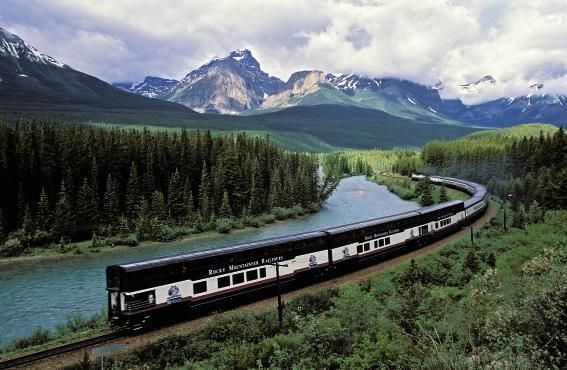It was a crazy gamble: uniting the provinces of the young federal state by rail and convincing British Columbia, in the far west, to join the dominion. This was done in 1886, with a small village called Vancouver as its terminal…
Today, for a crossing from the Atlantic to the Pacific, boarding takes place aboard the Canadian. This transcontinental, equipped with several double-decker domed cars, runs from Toronto to Vancouver and covers 4,466 kilometers in four days and four nights. It runs along the rivers of Ontario, crosses the Great Plains of Manitoba and then south-central Saskatchewan, and crosses the Rocky Mountains between Alberta and British Columbia.
More luxurious and entirely panoramic, the Rocky Mountaineer leads its passengers across fields in the Fraser Valley, into the forests and canyons of the Rocky Mountains, around turquoise glacial lakes and through UNESCO-listed Jasper and Banff National Parks. Three tours are offered in the footsteps of 19th century explorers, from four to 12 days, with overnight stays at the hotel.
The home of polar bears
It’s a completely different atmosphere that reigns in the train of the Klondike gold diggers. History buffs travel back in time, seated in vintage wagons pulled by a steam locomotive, from Carcross, Yukon, to Skagway, Alaska, with a stop in Bennett, one of the main miners’ towns from then. The construction of this railway line was a feat as it starts from sea level to climb almost 1,000 meters to the top of White Pass in just 32 kilometers, with 4% gradients. The return takes two hours by bus.
The most daring will venture into the Far North, on the route that connects Winnipeg, capital of Manitoba, to Churchill, home of the polar bears. In two days and two nights, the 1,697 kilometer route crosses the subarctic region where the forest of conifers and white birches meets the tundra, under the light of the famous aurora borealis.
In Northern Ontario, a day trip by train takes you to Agawa Park from Sault Ste. Marie to discover one of the oldest canyons, formed 1.2 billion years ago. years, 175 meters deep and inaccessible by road. Along the 183 kilometres, the guides recount the role of the Ojibwe, aboriginal fur traders who shaped this wilderness. On site, passengers have time to explore trails, lookouts, waterfalls and the nature that inspired the young Canadian painters of the Group of Seven at the beginning of the 20th century.
The highest tides in the world
Want to visit the Maritime Provinces? It’s in the ocean that you have to go up. It connects Montreal, the main city of Quebec, to Halifax, the capital of Nova Scotia. The 1,346 kilometer journey takes twenty hours. It goes through Bas-Saint-Laurent, Gaspésie and New Brunswick. A stopover in Moncton, founded by the Acadians in 1670, allows a getaway to the Bay of Fundy, renowned for its highest tides in the world – up to 16 meters of tidal range.
THE Train from Charlevoix offers a faster option. From Quebec to La Malbaie, located 125 kilometers further north, on the shore of the St. Lawrence, it passes through the coastal villages of Côte-de-Beaupré, then through those of the crater in the Charlevoix region. It stops in seven small towns, including Baie-Saint-Paul, which has the highest number of galleries per capita in Canada!
Long distance or short breaks, the railway is a nonchalant alternative to the most unusual discoveries.
